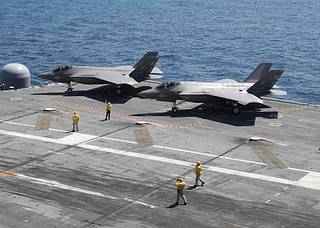
Similar
Two F-35C Lightning II aircraft assigned to the Grim Reapers of Strike Fighter Squadron (VFA) 101 sit on the flight deck of the Nimitz-class aircraft carrier USS Abraham Lincoln (CVN 72).
Summary
ATLANTIC OCEAN (Sep. 04, 2017) Two F-35C Lightning II aircraft assigned to the Grim Reapers of Strike Fighter Squadron (VFA) 101 sit on the flight deck of the Nimitz-class aircraft carrier USS Abraham Lincoln (CVN 72). Abraham Lincoln is underway conducting training after successful completion of carrier incremental availability. (U.S. Navy photo by Mass Communication Specialist 3rd Class Matt Herbst) File# 170904-N-UX312-0183
Aircraft carriers are warships that act as airbases for carrier-based aircraft. In the United States Navy, these consist of ships commissioned with hull classification symbols CV (aircraft carrier), CVA (attack aircraft carrier), CVB (large aircraft carrier), CVL (light aircraft carrier), CVN (aircraft carrier (nuclear propulsion) and CVAN (attack aircraft carrier (nuclear propulsion). The first aircraft carrier commissioned into the United States Navy was USS Langley (CV-1) on 20 March 1922.
The Lockheed Martin F-35 Lightning II is the fifth-generation combat aircraft, a single-seat, single-engine, all-weather stealth multirole fighter designed to perform ground-attack and air-superiority missions. It has three main models: the F-35A conventional takeoff and landing (CTOL) variant, the F-35B short take-off and vertical landing (STOVL) variant, and the F-35C carrier-based catapult-assisted take-off but arrested recovery (CATOBAR) variant. The F-35 descends from the Lockheed Martin X-35, the winning design of the Joint Strike Fighter (JSF) program. It is built by Lockheed Martin and many subcontractors, including Northrop Grumman, Pratt & Whitney, and BAE Systems. The most expensive $400-billion military program ever, the F-35 became the subject of much scrutiny and criticism in the U.S. and in other countries. By 2014, the program was $163 billion over budget and seven years behind schedule. The Air Force’s F-35A appears to be exempt from the major flaws, but the Marine Corps’ vertical-landing F-35B and the Navy’s carrier-compatible F-35C both suffer what the services call “category 1” deficiencies. The problems might also help to explain why US defense secretary Patrick Shanahan reportedly described the F-35 program as “f... up.” Some NATO members and close U.S. allies, including the United Kingdom, Italy, Australia, Canada, Norway, Denmark, the Netherlands, and Turkey contribute to its development. These funders generally receive subcontracts to manufacture components for the aircraft. The U.S. plans to buy 2,663 F-35s, which will provide the bulk of the crewed tactical airpower of the U.S. Air Force, Navy, and Marine Corps in coming decades.
Tags
Date
Location
Source
Copyright info



































